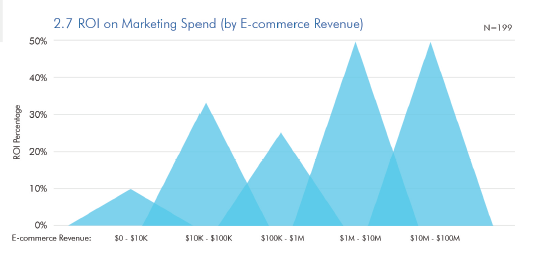It is always good to see how your business performs in comparison with peers. Earlier I wrote couple posts about one good metric that in my opinion all businesses should track – Return On Marketing Investments (ROMI): how calculate it (methodology) and simple online ROMI calculator. Now I have found some data that let you to compare your return rate with ROMI of other e-commerce retailers.

The chart above show ROMI (in percent) on marketing spent collected by Marketing Sherpa as a part of their eCommerce Benchmark Study. It shows median (50th percentile) for ROI on marketing spend (way Marketing Sherpa calls ROMI) for retailers with different e-commerce revenue. If you not very familiar with statistic media means that half of the businesses reported ROMI higher (and another half lower) than median number. Note that median is different from mean (average), but probably that’s enough about statistic basic.
So you may see that for bigger businesses with revenue above $1M per annum median ROMI was 50% and more. Smaller businesses did not so good, with the lowest mean of 10% for e-retailers with below $10K annual revenue. My explanation of that results is economy of scale that larger businesses can achieve and possibility to employ (in-house or outsourced) more qualified experts in digital marketing, who look after their campaigns.
Other findings from the research related with ROMI:
- Over 50% of responders reported that ROMI is rising, for 20% it is steady and 10% reported falling ROMI. I guess that remaining 20% didn’t answer;
- Interesting that when ROMI were count on all channels revenue (not just e-commerce), only retailers in $1-10M bracket have mean 50%, for all other businesses (bigger and smaller) ROMI is lower;
- Retailers with highest ROMI reported growth more often that those with lowest, so there is a kind of virtual or vicious circle effect.
I noticed that the sample size of responders who answered this section is quite small – just a bit over 200 from the total over 4,000 participants of the study (5%). I suspect this means that unfortunately not so many businesses track return on their marketing investments, which is a shame. Hopefully the situation improves in the future.
One thought on “Return on marketing investments – benchmark data”